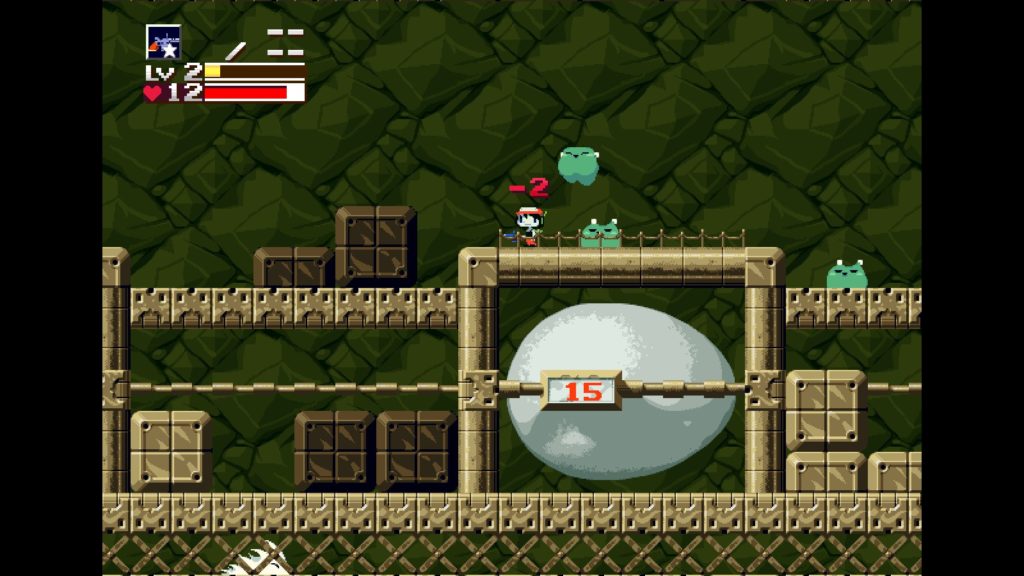Feedback is a concept which manifests in a broad variety of environments, from the natural world to human interaction, from education to engineering. Where complex systems interact, there are often designated cycles of response to change, which are referred to as feedback loops. Feedback loops come in two main varieties—positive and negative—differentiated by how the systems respond to change. Positive loops reinforce the change, while negative loops maintain balance by working against change. Video games, as complex systems themselves, utilize feedback loops in response to player action, most frequently whether they’re doing well or poorly at proceeding. The two games we’ll be looking at today are Cave Story and Kero Blaster—relatively similar games for ease of comparison and both creations of Daisuke “Pixel” Amaya.
We’ll start by taking a look at the feedback loop present in Cave Story. Cave Story utilizes a weapon energy system similar to the experience found in most RPGs. Enemies drop energy when defeated (assuming they don’t drop a recovery pickup), and when collected, it adds to the active weapon’s energy. With

enough energy, the weapon levels up and becomes more effective—with a sole exception later in the game. The other side of the coin is what happens when the player is hit: the active weapon loses two points of energy for every point of damage taken. This results in a positive feedback loop. Avoiding damage keeps weapons at a high level, which defeats enemies faster and offers less chance to take damage; taking damage weakens weapons and makes enemies survive longer and have more chances to attack.

A player who is struggling will fall faster, where a player who is doing well will continue to gain the power to keep doing well.
Conversely, Kero Blaster’s progression is driven by a negative feedback loop. Each stage of the game has a shop about halfway through, where the player can spend money earned up to that point on upgrades for weapons, maximum health, and

the like. What makes this a negative feedback loop is, once again, the impact of being defeated. Where Cave Story resets the player from their last save, a game over in Kero Blaster sends them back to the beginning of the stage, keeping all money, upgrades, and the like gained beforehand. Thus, the player has the opportunity to gain more money leading up to the shop on their next run, potentially making more upgrades available and resulting in a

larger potential pool of money for a struggling player than for a player with no problems. Getting through the levels without issue means less money earned overall, and potentially fewer chances for available upgrades, where a player who needs a few tries to overcome challenges will have the added boost of more money for upgrades to help them along.
Now that the two systems have been elaborated on, I want to make one thing very clear: both of these progression systems work. Neither one is necessarily better than the other. In fact, the systems present lend themselves well to the games they’re present in. As mentioned above, Cave Story resets the player to their last save point on death. The game has no lives system,

one death is all the player gets. However, the game is a continuous narrative with connected areas, where the state of the player on completing one area will carry over into the next—health, ammo, energy, and all. A player who is struggling will be forced to fall faster because it allows them a second chance to move in at full strength, and perhaps complete their objective in better shape for future ones. The game is more challenging than Kero Blaster, but it has to be to prepare players for all of its obstacles.
Kero Blaster’s levels carry over lives and money, but health is restored to maximum each time. The state of a player on completing a level does not impact their state on starting the next. As such, players who don’t need help will not receive as much, but players whose progress is consistently blocked will be offered new power to help them break through. This also offers another challenge to those who don’t need as much help:

prioritizing their use of currency. When it’s in short supply, the upgrades purchased matter more, and there must be a careful balance of what is purchased when. The challenges presented to a skilled player and the help presented to a less skilled player help to maintain an even balance without blatantly punishing success or holding hands that don’t want to be held.
Kero Blaster and Cave Story are some of the clearest examples of the two main types of feedback loops, but they aren’t by any means the only ones. Most games implement feedback loops of some sort to keep players in a state of challenge without feeling helpless. When used effectively, they can strike the right balance between the two and become more engaging experiences as a result. Other times, a game adjusts too much and puts people off. No system is perfect, but Cave Story and Kero Blaster respond to player progress in ways that fit well where they are and reinforce the mechanics and priorities present in the broader scope of each game.
As an added bonus, here’s a video showing the systems in action!

Oh cool, there’s footage with this one! Also, aw, Basil